
Birding Around Las Vegas, Red Rock Canyon National Conservation Area

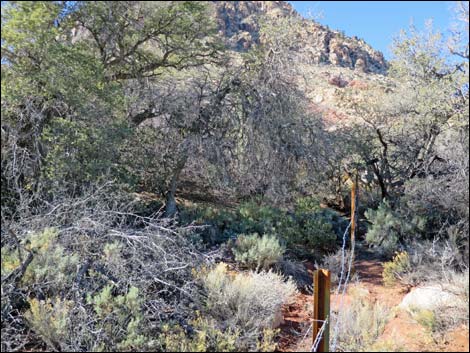 Lone Grapevine Spring under oak trees |
Description There are several springs along the south end of the Red Rock Cliffs escarpment that attract birds and other wildlife. Four springs are accessible from not-always-well-maintained dirt roads (should be suitable for carefully driven sedans) and walks of no more than about 1 mile round-trip each. As with other birding sites in the Red Rock area, these are not birding hot spots, but they do provide precious water for desert birds and other wildlife, attracting species from miles around. Water at each spring supports a desert "oasis" with thickets of shrubby vegetation and trees such as oak, ash, and mesquite, all of which are surrounded by dry Mojave Desert Scrub vegetation. |
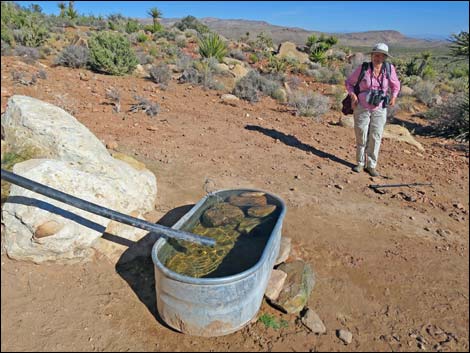 Watering trough below Lone Grapevine Spring |
Location The Cottonwood Valley area springs are located in the Red Rock Canyon National Conservation Area on the west side of the Las Vegas Valley, about an hour from downtown, but not in the Scenic Loop Road fee area. From the Red Rock Visitor Center area, drive west then south on West Charleston Blvd (Hwy 159) past Blue Diamond Town to Highway 160. Turn right onto Highway 160 and drive west for 4.7 miles to the paved Late Night Trailhead on the right. From the end of the paved parking area, follow Black Velvet Road for 1.3 miles to either of two roads to the left. These roads merge to become Lone Grapevine Road, which leads to Mud Spring #2 Parking and the Lone Grapevine Trailhead. Continuing straight on Black Velvet Road another 1.3 miles leads to Black Velvet Trailhead at the end of the road. |
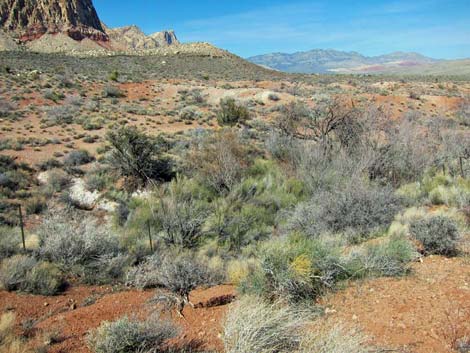 Mud Spring No. 1 |
Mud Spring No. 1. From the Black Velvet Trailhead, a use-trail leads south for about 0.6 miles to a spring. The trail runs out across open desert, passes two wet areas, and continues to Mud Spring No. 1 with honey mesquite, velvet ash, desert willow, and other desert wetland vegetation. This is a quiet place to stop, relax, "smell the roses," and watch a few birds. A watering trough at the second wet area and a guzzler at the main spring provide water for birds and other wildlife. |
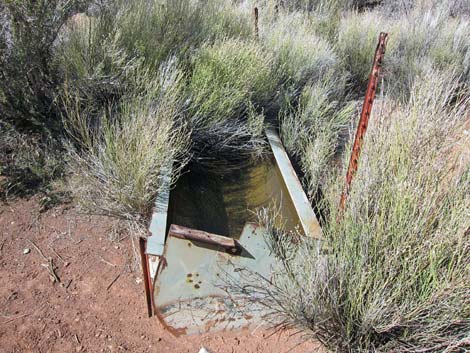 Watering trough along trail to Mud Spring No. 1 |
Mud Spring No. 2. From Black Velvet Road, turn left onto Lone Grapevine Road and drive west for 0.5 miles to a 2-3 car parking area on the right at the edge of a bluff overlooking the wash. From the trailhead, use-trails lead off the bluff and down to the wash below. Water sometimes flows at this point, but turn upstream and walk west to a red-mud cliff at the edge of the spring (about 800 feet total distance). Honey mesquite, velvet ash, desert willow, cattails, and other wetland vegetation provide cover and feeding areas for birds and other wildlife that come to drink from the spring and outflow stream. |
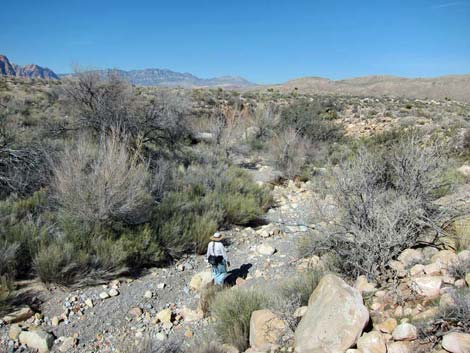 Mud Spring No. 2 |
Lone Grapevine Spring. From Lone Grapevine Trailhead Parking Area #1, either walk or drive a 4WD vehicle to Lone Grapevine Trailhead Parking Area #2. From the trailhead, a use-trail leads west for about 0.5 miles to a spring with oak trees and petroglyphs at the base of the Red Rock Escarpment. A trough provides water for domestic horses and wildlife at the base of a hill, and trees and surface water up the hill at the spring provide cover, food, and water for native wildlife and birds. |
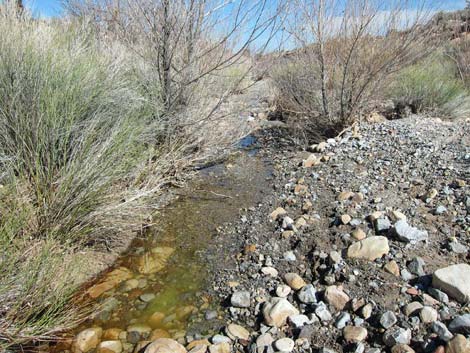 Mud Spring No. 2 outflow stream |
Wooden Fence Spring. From Lone Grapevine parking area #1, either walk or drive a 4WD vehicle to Lone Grapevine Trailhead Parking Area #4. From the trailhead, a use-trail leads west for about 0.3 miles to a spring with oak trees, lots of shrubby vegetation, and even aquatic vegetation such as cattails. Trees, shrubs, and surface water provide cover, food, and water for native wildlife and birds. |
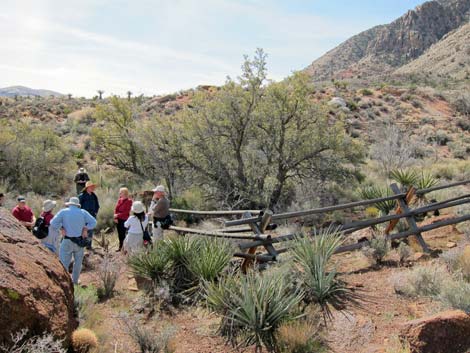 Wooden Fence Spring |
Hours Day-use only: sunrise to sunset. Fees None. |
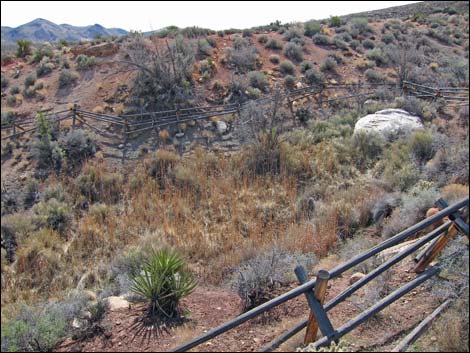 Wooden Fence Spring marsh area |
Specialties Desert species (e.g., Woodhouse's Scrub-Jay, Verdin, Anna's Hummingbird, Mourning Dove, Phainopepla, House Finch, Gambel's Quail, and Rock Wren) can be found here all year. During migration, watch for warblers, tanagers, orioles, and other species as they pass through the area. During summer, watch for hawks, warblers, flycatchers, sparrows, and Cactus Wrens. Watch for side-blotched lizards, desert spiny lizards, coyotes, and small mammals (e.g., white-tailed antelope squirrels, black-tail jackrabbit, kangaroo rat tracks and burrows in the sand). I've seen rattlesnakes here too, so watch your step on trails in overgrown areas. |
Happy birding! All distances, elevations, and other facts are approximate.
![]() ; Last updated 240323
; Last updated 240323
| Birding Around Las Vegas | Southern Nevada Birds | Guide Service | Copyright, Conditions, Disclaimer | Home |